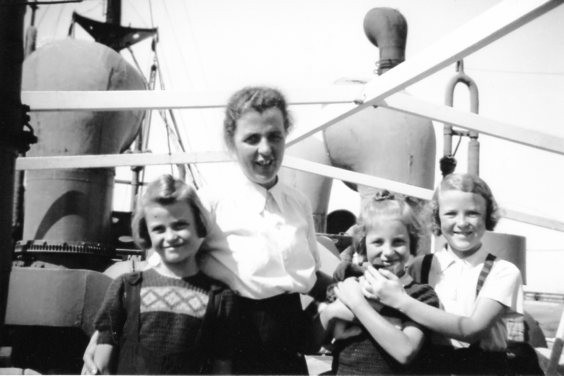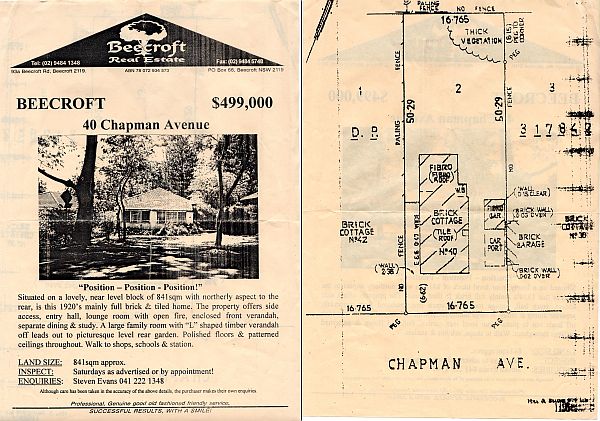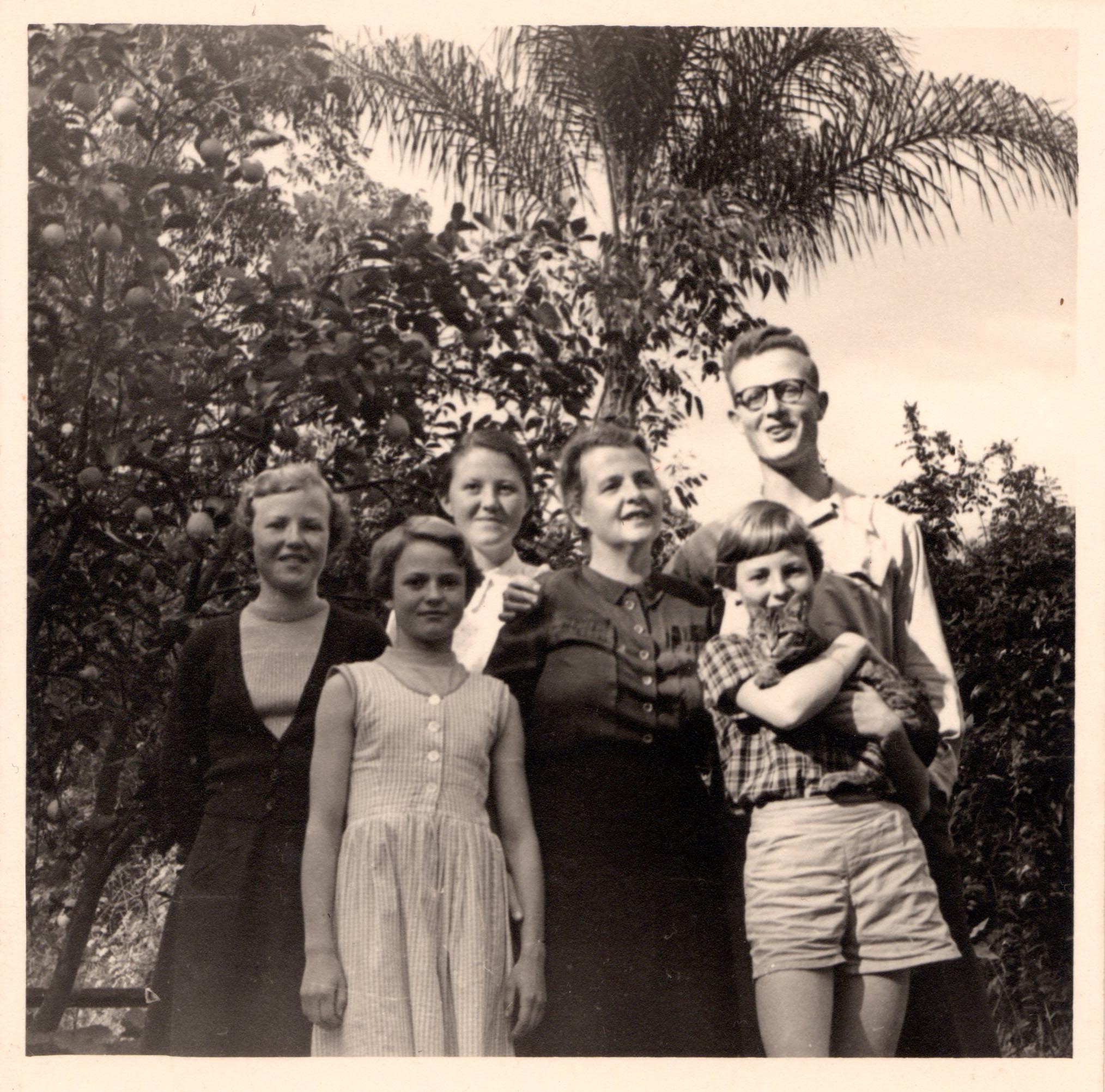The Cremers : A German family in post war Beecroft.
Gundel Briggs’s story.

When, In September 1950, Lotte Cremer and her five children sailed into Sydney Harbour to be reunited with her husband Wilhelm, the couple had been apart for nine years. Although they were both German nationals, their children, Kurt aged 16, Marianne 14, Gundel 11 and twins Ingrid and Sigrid 9, were all born in Iran.
In the 1930s Wilhelm Cremer was part of a community of well-qualified Germans working on development projects in Iran. An engineer by training, he helped set up technical schools and later worked in them, training Iranians. Wilhelm and Lotte had a comfortable life within this small community, even after WW11 broke out in 1939, until, in 1941, British and Russian forces invaded Iran. Although the Shah of Iran was officially neutral he was known to be pro-German. The invasion was to secure the Iranian oil fields for the Allies.
Wilhelm Cremer spent some six weeks in gaol in Basra and then was told he would be interned by the British in either India or Australia. He was shipped to Australia, as part of a contingent of enemy aliens and interned at camps in Tatura in Victoria and subsequently at Loveday in South Australia. Lotte, who had 3-week old twin babies, was in no position to travel with him.
Lotte and her children were transported via Istanbul to Germany, a journey of three months by rail. For the remaining years of the war they lived for the most part in a village near Koln. It took some time for the Red Cross to locate them and Lotte and Wilhem were able to exchange letters monthly until his release in 1946 when Wilhelm accepted an offer from Immigration Minister Arthur Calwell to settle in Australia. In post-war Australia this man talented in design and manufacturing scrambled to earn money by making decorative objects in metal in a shared enterprise with other German ex-internees. He sent money to his wife and children in Germany, but it was hard, with his meagre income, to save for the fares to bring them to Australia and also provide a home.

He discovered a love for the bushland areas of northern Sydney and purchased a block of land at Mt Colah in anticipation of building a home. Eventually, after much uncertainty, a worldwide Lutheran organisation gave him some funds and lent him more, which had to be repaid. With a small loan from an Australian friend and after selling the land in Mt Colah, he bought a small two-bedroom brick home at 40 Chapman Avenue, Beecroft (now demolished) where the family settled. It was the beginning of many years of living in an environment the Cremers loved.
Settling in
At that time Australian professional organisations did not recognise degrees from universities other than English institutions, but he found employment as an engineer in a factory at Meadowbank operated by a man who came from an Australian family of German origin. The plant manufactured small electrical appliances.
Wilhelm made furniture for the home from whatever materials he could scrounge. Later he extended the house to provide one large additional living space. In one of the two bedrooms the four girls slept in bunk beds he constructed and Kurt made his bed in the lounge room. Wilhelm also created outdoor furniture from found materials. Somehow, there were nooks where the children could do homework and study. Neither parent was fluent in English in their early years in Australia. Their second daughter, Gundel Briggs, says that for many years the parents spoke to the children in German and they answered in English.
Starting school in Australia
Kurt, 16, and Marianne, 14, had learned some English at school in Germany and both were dedicated and able students. Kurt travelled to Homebush Boys’ High School and Marianne was enrolled at Hornsby Girls’ High. Both did well academically and eventually attended Sydney University. The twins entered third grade at Beecroft Primary and Gundel was enrolled in fifth grade there, although she had very little English.
The teachers at Beecroft Primary lacked training and experience in teaching children who were from a non-English speaking background. Soon after her arrival, the Headmaster at Beecroft Primary, Mr Thomas Albertson, called Gundel into his office and gave her a lesson in the English alphabet from a simple primer used by the kindergarten teacher. She, a good reader in her native language, felt humiliated.
A little more than a year later she was still not fluent in English when she entered high school at Hornsby Home Science High School (the site is now occupied by Hornsby College of TAFE). She completed the last two years of her schooling at Burwood Girls’ High School which she enjoyed as there was an emphasis on art and crafts which she loved. She was keen to maintain her German and was able to pass this subject in the Leaving Cerificate examination with the assistance of the German teacher at Hornsby Girls’ High School, who had taught her sister Marianne.

Fitting in
It was a long time before Wilhelm and Lotte could afford to buy school uniforms for all the children. On arrival they looked ‘foreign’ with ‘strange’ hair styles and clothes but Kurt proudly wore a navy Air Force jacket his father had sent him from Australia.
The children were well accepted by their Australian classmates (there were no other children from non-English speaking families in Beecroft Primary school). She soon made two very good friends, Carol Wilson, from a Salvation Army family, who lived in Hull Road, and Mary Ray, who lived in Sutherland Road. Carol sometimes invited her home after school and read with her. The twins, Ingrid and Sigrid, joined Beecroft Girls’ Club, organised by ‘Squire’ Nathan where girls enjoyed physical education classes in the Presbyterian church hall. Gundel recalls that she felt awkward and ill at ease, and lacked confidence in this new environment, especially as she was not interested in sports.
The girls all worked in the holidays and whenever they could, finding jobs as babysitters. The money they earned contributed to the family income – it was not their pocket money. As Gundel enjoyed sewing she made her own and her mother’s clothes, often buying fabrics from Johnson’s store in Eastwood. She also made curtains for the windows. When he was at university, her brother Kurt bought her a new Phaff electric sewing machine with his savings.
The Cremers were not a religious family. If they attended church it was usually at the Lutheran Church in Sydney, where Gundel was confirmed and two of her sisters were married. In Beecroft the children were allowed to go to whatever Sunday schools they chose. Gundel recalls attending Fellowship at St John’s where the children sat in a circle reading aloud in turn from the Bible. Afraid of stumbling over unfamiliar English words and being laughed at, she would silently read ahead, calculating which portion would be hers to read and trying to practise so she would not stumble. She soon left the Fellowship, the stress being too great. Later Gundel joined in the social activities of a Quaker community.
Although her parents were well accepted by their neighbours, they mainly socialised with other German-speaking migrants. These friends lived at locations across Sydney including Chatswood and Wahroonga. They became close to one other local family of German origin, the Wohlwills, who lived in Murray Road. The Wohlwills had arrived in Australia during the 1930s. They had three daughters, Monica, Sabina and Renata. Their mother, Erica was a close friend of conservationist Marie Byles and through Erica, the Cremers met Marie Byles. Gundel recalls once spending a night in The Hut of Happy Omen on Marie’s property in Cheltenham. She felt that Day Road was the most beautiful street in the area.
When she left school Gundel obtained a Teachers’ College scholarship and trained as an Infants and Primary teacher at Bathurst Teachers’ College. After graduation, she taught at tiny and remote Central Tilba school for a year and then for another two years at Dapto. She then embarked on travel in Europe for a year during which time she met Stewart Briggs, another young Australian from Sydney travelling around Europe.
When she had cleared all her debts from this adventure they had a simple wedding with just a few witnesses at the Anglican church in Bellingen. She and her sisters accepted that her parents were not in a position to pay for weddings for their daughters. Stewart’s savings purchased a block of land in Kethel Avenue, Cheltenham where they built a home and brought up their two children. They lived there for forty years.
They still live in Beecroft, in a home with a beautiful outlook over the bushland Gundel loves. Their daughter and her family live nearby. Gundel’s parents continued in retirement to live in Beecroft and also enjoyed spending time in a holiday cottage in Kangaroo Valley.
Lesley Goldberg
(This article is based on an interview with Gundel Briggs. c 2014)
